|
|
 |
|
Calanoida ( Order ) |
|
|
|
Arietelloidea ( Superfamily ) |
|
|
|
Heterorhabdidae ( Family ) |
|
|
|
Disseta ( Genus ) |
|
|
| |
Disseta scopularis (Brady, 1883) (F,M) | |
| | | | | | | Syn.: | Leuckartia scopularis Brady, 1883 (p.51, Descr.M, figs.M);
Disseta maxima Esterly, 1911 (p.330, figs.F); Sewell, 1948 (p.553, 563); C.B. Wilson, 1950 (p.198); Brodsky, 1950 (1967) (p.344, figs.F); Lee & al., 1971 (p.1151); Galbraith, 2009 (pers. comm.) | | | | Ref.: | | | A. Scott, 1909 (p.134, figs.M); Sewell, 1947 (Rem.: p.189); C.B. Wilson, 1950 (p.198, Redescr.F,M, figs.F,M, Rem.); Tanaka, 1964 a (p.34, figs.F,M); Chihara & Murano, 1997 (p.816, Pl.117: F,M); Park, 2000 (p.18, figs.F,M, Rem.) | 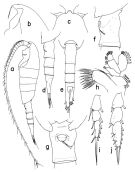 issued from : T. Park in Bull. Scripps Inst. Oceanogr. Univ. California, San Diego, 2000, 31. [p.156, Fig.4]. Female: a, habitus (left side); b, c, forehead (left, dorsal, respectively); d, e, urosome (left, dorsal, respectively); f, g, genital somite (left, ventral, respectively); h, left Mx1 (posterior); i, exopod of P1 (anterior); j, exopod of P2 (anterior). Nota: Dorsally, genital somite relatively long, with tubercular lateral swellings; P5, 2nd exopodal segment with a long outer spine.
|
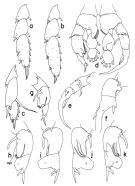 issued from : T. Park in Bull. Scripps Inst. Oceanogr. Univ. California, San Diego, 2000, 31. [p.157, Fig.5]; Female: a, exopod of P3 (anterior); b, exopod of P4 (anterior); c, exopod of P5 (anterior). Male: d, P5 (anterior); e, exopod of left P5 (posterior); f, idem (with proximal and distal parts omitted), anterior; g, exopod of right P5 (posterior); h, idem (anterior); i, idem (anterior, tilted counterclockwise); j, idem (posterior); k, idem (posterior, tilted clockwise). mpr = medial projection.
|
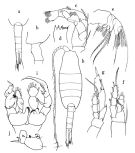 issued from : O. Tanaka in Publs Seto Mar. Biol. Lab., 1964, XII (1). [p.35, Fig.191]. Female: a, urosome (dorsal); b, last thoracic segment and genital somite (lateral left side); c, A2; d, masticatory edge of Md; ; e, Mx2; f, P1; g, P5. Nota: A1 exceed the end of the furca by distal 5 segments. The urosome segments and furca are in the proportional lengths as 31:15:13:10:31 = 100 Male: h, habitus (dorsal); i, P5; j, 2nd and 3rd segments of exropod right P5. Right A1 exceeds the end of the furca by distal 2 segments. Left A1 forming a grasping organ. The urosome segments and furca (left) are in the proportional lengths as 13:16:16:13:11:31 = 100.
|
 issued from : A. Scott in Siboga-Expedition, 1909, XIX a. [Plate XLII, Figs.1-9]. Male (from Banda Sea): 1, habitus (dorsal); 2, forehead (lateral); 3, last thoracic and genital segments (left side); 4, Md (biting edge); 5, Mx1; 6, Mx2; 7, P1; 8, end segment of exopodite of P4; 9, P5 (L= left leg, R = right leg).
|
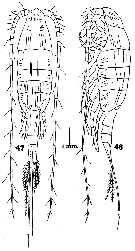 issued from : C.B. Wilson in U.S. National Museum. Bull.100, 14 (4), 1950. [Pl.6, Figs.47, 48]. Female: 47, habitus (dorsal); 48, idem (lateral left side).
|
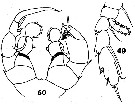 issued from : C.B. Wilson in U.S. National Museum. Bull.100, 14 (4), 1950. [Pl.6, Figs.49, 50]. Female (E tropical Pacific ): 49, P5. Male: 50, P5.
|
 issued from : C.O. Esterly in Univ. Calif. Publs Zool., 1911, 6 (14). [Pl.29, Figs.54, 58]. As Disseta maxima. Female (from San Diego Region): 54, forehead (lateral); 58, part of thorax and urosome (lateral, right side). Nota: Left caudal ramus longer than the right by about one-third the length of the latter. A1 very long, one-fitth of their length longer than the body. Genital segment as long as the other three together, and the anal segment less than one-third the length of the genital. The genital eminence is at middle of the segment. Nota after Brodsky (1950 [1967]): Diagnostic characters female: Inner bristle of 2nd segment of exopodite of P5 very long and massive, longer than distal segment of same exopodite.
|
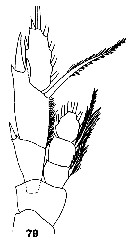 issued from : C.O. Esterly in Univ. Calif. Publs Zool., 1911, 6 (14). [Pl.30, Fig.79]. As Disseta maxima. Female: 79, P5.
|
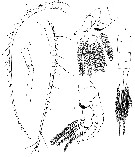 Issued from : G.S. Brady in Rep. Scient. Results Voy. Challenger, Zool., 1883, 8 (23). [Pl. XIV, Figs.1-5] Male: 1, Right A1; 2, geniculating portion of left A1; 3, left P5 (on complete); 4, right P5; 5, urosome.
|
 Disseta scopularis Disseta scopularis female: 1 - Dorsally, genital somite (Fig.4-e) relatively long, with tubercular lateral swellings. 2 - P5 2nd exopodal segment with a long outer spine (Fig.5-c).
|
 Disseta scopularis Disseta scopularis male: 1 - Left P5 (Fig.5-f), 2nd exopodal segment without a large lateral spiniform process. 2 - Left P5 (Fig.5-d), 2nd endopodal segment without an anterodistal lobe; 3nd exopodal segment with a large terminal spine.
| | | | | Compl. Ref.: | | | Sewell, 1948 (p.558, 560, 562, Rem.); Itoh, 1970 a (p.5: tab.1); Galbraith, 2009 (comm. pers.); in CalCOFI regional list (MDO, Nov. 2013; M. Ohman, comm. pers.) | | | | NZ: | 8 | | |
|
Distribution map of Disseta scopularis by geographical zones
|
| | | | | | | Loc: | | | Indonesia-Malaysia (Molucca Sea), Philippines, China Seas (East China Sea), Japan (Izu, Sagami Bay), off British Columbia, off San Diego, Pacif. (tropical), off Peru, SW Galapagos, NE Marquesas Is., off Chile | | | | N: | 9 | | | | Lg.: | | | (5) M: 9,75; (121) F: 9,6; M: 8,76; (137) F: 11-10; M: 9,5-9; (143) F: 9,4; (824) F: 10,66-8,66; M: 10-8,5; {F: 8,66-11,00; M: 8,50-10,0} | | | | Rem.: | bathypelagic.
For Itoh (1970 a, fig.2, from co-ordonates) the Itoh's index value of the mandibular gnathobase = 1090.
Park (2000, p.143) found this species only in the low and midlatitudes in the Pacific fromthe west coast of the Americas to the Malay Archipelago. | | | Last update : 17/10/2017 | |
|
|
 Any use of this site for a publication will be mentioned with the following reference : Any use of this site for a publication will be mentioned with the following reference :
Razouls C., Desreumaux N., Kouwenberg J. and de Bovée F., 2005-2025. - Biodiversity of Marine Planktonic Copepods (morphology, geographical distribution and biological data). Sorbonne University, CNRS. Available at http://copepodes.obs-banyuls.fr/en [Accessed July 03, 2025] © copyright 2005-2025 Sorbonne University, CNRS
|
|
 |
 |












